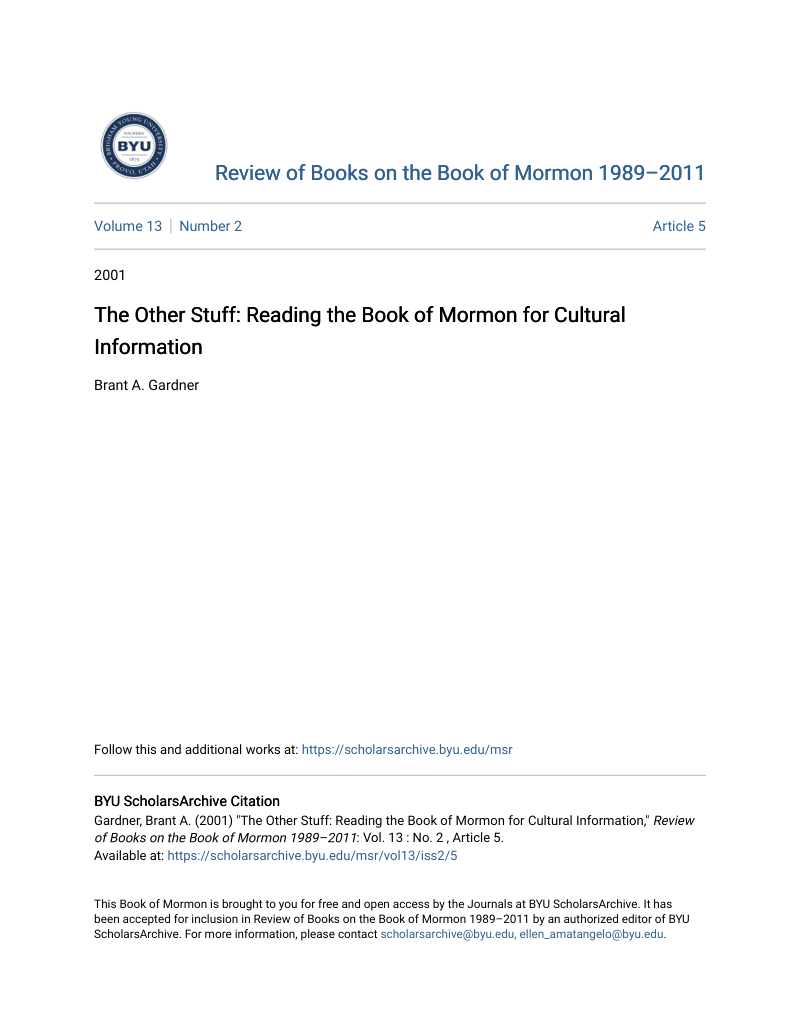Brant A. Gardner argues that the BOM speaks of the presence of non-Lehites in ancient America.
- Type
- Academic / Technical Report
- Source
- Brant A. Gardner LDS
- Hearsay
- Direct
- Reference
Brant A. Gardner, "The Other Stuff: Reading the Book of Mormon for Cultural Information," FARMS Review of Books 13, no. 2 (2001): 21–52
- Scribe/Publisher
- FARMS Review
- People
- Brant A. Gardner
- Audience
- Reading Public
- Transcription
It is probable that the first contact would have been on a level at which the groups did not join permanently, but perhaps a friendly hamlet extended hospitality to the newly arrived people with strange customs. After some time together, residents of the hamlet would have found that the newcomers had enviable skills. The Lehites had come from a much more complex society (for all that the hamlet might have been tangentially attached to a larger center, they would not have had the benefits of that center localized in the hamlet). The newcomers also worked with metal, an expertise that would be desirable (Nephi works metal to make tools for their vessel-see 1 Nephi 17:8-11, 16-and to fabricate the plates on which he engraves his record-see 1 Nephi 19:1; 2 Nephi 5:28-30).
On the other hand, the Lehites would have welcomed a friendly hamlet and would have found tremendous benefit in associating with natives of the land. The new land offered new challenges and, for a people who were required to make many of their own personal goods, knowing where to find game, where and how one might cultivate, and where to find appropriate raw materials for such things as pottery and clothing would be invaluable information that would save the Lehites a tremendous amount of time and effort.
Does the text lend any credence to the idea that "others" had come into the Lehite colony this early? Nothing points definitively to that conclusion, but on at least one occasion (in 2 Nephi 5:6) the most plausible explanation rests squarely on the presence of "others."
. . .
The best hypothesis, then, to explain Nephi's mention of "all those who would go" is that he referred to those of the hamlet or hamlets who had joined with the Lehites and who, in recognition of the greater social and technological sophistication of the newcomers, had permitted them to occupy roles of leadership over their hamlet in exchange for the new knowledge or goods they brought with them (in addition to the gathering power of religious conversion; see 2 Nephi 5:6). Indeed, Nephi's descriptions of "his people" begin very early to have the appearance of referring to more than the named individuals, if only in the characterizations of the activities mentioned, activities that, from Sorenson's internal perspective, would indicate a larger population.
- Citations in Mormonr Qnas
The B. H. Roberts Foundation is not owned by, operated by, or affiliated with the Church of Jesus Christ of Latter-day Saints.

